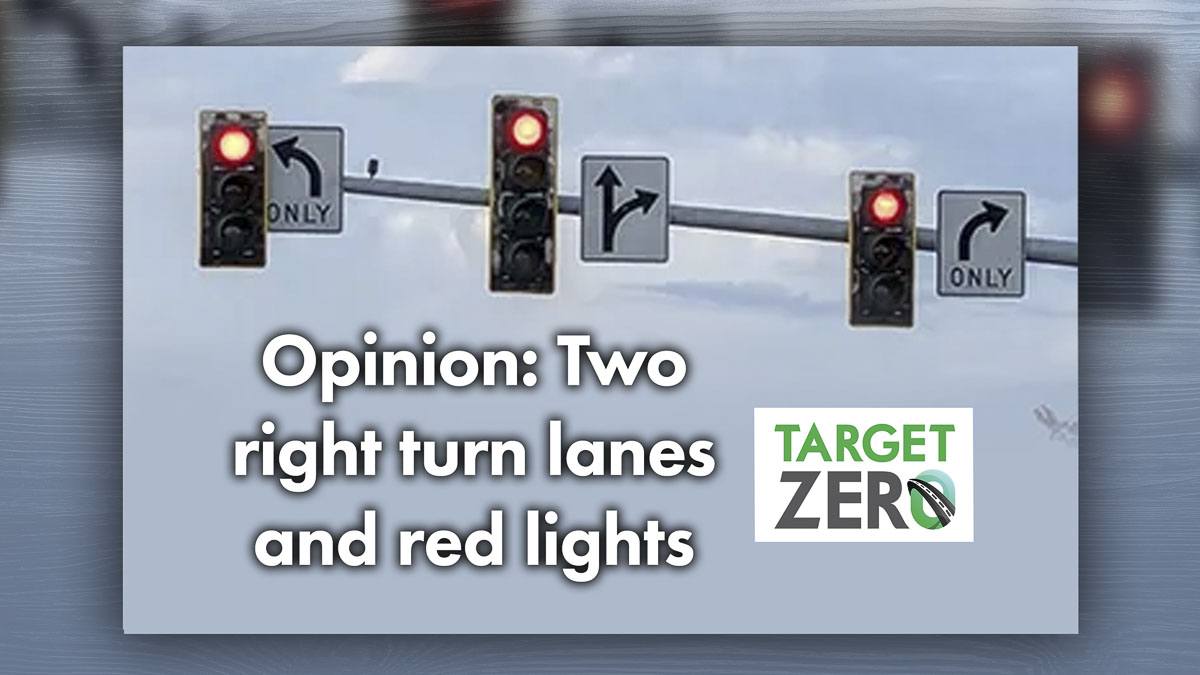
Target Zero Manager Doug Dahl answers a question about two-lane right turns
Doug Dahl
The Wise Drive
Q: I have a question about two-lane right turns. Can you take a right turn on a red light on the outer lane of the two lanes too? Everybody does it, but I’m never sure if I am really allowed to do it.
A: For the people who need an answer to this question right now, yes, you can make a right turn on a red light in either lane. The same rules apply to both lanes. And for the folks who aren’t willing to accept a “yes” without evidence, even if it’s the answer you want, thank you for your skepticism. The most important time to question something is when it aligns with the outcome you were hoping for.

The Revised Code of Washington has the evidence you’re looking for, so we’ll start there. And then as a bonus, we’ll take a look at another law that, on the face of it, would seem to outlaw a second right turn lane entirely.
To make sure we’re all driving in the same clown car, let’s review the right turn on red (RTOR) law. At a red light (including a red arrow), a driver intending to take a right turn (or a left turn onto a one-way street) may, after stopping for the red light and yielding to other cars and pedestrians (and as of 2019, personal delivery devices) in the intersection, make their turn. Of course, when a sign is posted prohibiting a right turn on red, it’s not allowed.
I said the law has the evidence, but the proof is more of an absence of evidence. The law doesn’t specify that a RTOR is only allowed in the furthest right lane or make any statement prohibiting right turns from an additional right-turn lane.
So yes, you can make a right turn on red from either right turn lane. I’d like to point out though, that the law states that a driver “may, after stopping proceed to make a right turn.” It is an option, not a requirement. You probably see where I’m going with this; some drivers might not to take the turn because they see something you don’t, some might know that right turns on red lights account for a disproportionately high number of crashes with pedestrians so they’ve chosen not to take them, some may not know they can. With all those possibilities, right turns at red lights are an opportunity to practice patience.
If you do decide to take that right turn, stay in your lane through the intersection. The law doesn’t call this out specifically, but does state that a driver shall not move from a lane until they have “ascertained that such movement can be made with safety.” The Washington Driver Guide, and every driving instructor I’ve asked, presumes that it’s unsafe to make a lane change in an intersection.
And the bonus: There’s a law that requires drivers making right turns to do so “as close as practicable to the right-hand curb or edge of the roadway.” That extra right-turn lane certainly isn’t close to the edge of the roadway, so how do you comply with the law if you’re in that lane? It comes down to the word “practicable,” which is often defined as “feasible or capable of being done.” If you’re the only vehicle approaching the intersection, you can set up at edge of the roadway to make your right turn. But if traffic has filled both lanes, “as close as practicable” could be understood as “as close as you can without becoming a hazard to other vehicles.”

The Wise Drive is hosted by Doug Dahl, a Target Zero manager for the Washington Traffic Safety Commission.
Also read:
- POLL: Why did voters reject all three tax proposals in the April 22 special election?Clark County voters rejected all three tax measures on the April 22 special election ballot, prompting questions about trust, affordability, and communication.
- Opinion: The war on parental rightsNancy Churchill argues that Olympia lawmakers are undermining voter-approved parental rights by rewriting key legislation and silencing dissent.
- Opinion: An Earth Day Lesson – Last year’s biggest environmental victories came from free marketsTodd Myers argues that Earth Day should highlight free-market solutions and grassroots innovation as more effective tools for environmental stewardship than top-down mandates.
- Opinion: Time to limit emergency clauses and give voters a choiceTodd Myers urges the governor to remove emergency clauses from bills that appear intended to block voter input rather than address real emergencies.
- Letter: C-TRAN Board improper meeting conductCamas resident Rick Vermeers criticizes the C-TRAN Board for misusing parliamentary procedure during a controversial vote on light rail.










